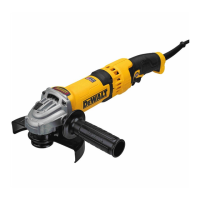ENGLISH
9
3. Place wheel
17
against the backing flange,
centering the wheel on the raised center (pilot) of the
backingflange.
4. While depressing the spindle lock button and with the
hex depressions facing away from the wheel, thread the
threaded locking flange
4
on spindle so that the lugs
engage the two slots in the spindle.
NOTE: If the wheel you are installing is more than 1/8"
(3.17mm) thick, place the threaded locking flange on
the spindle so that the raised section (pilot) fits into the
center of the wheel. If the wheel you are installing is
1/8" (3.17mm) thick or less, place the threaded locking
flange on the spindle so that the raised section (pilot) is
not against thewheel.
Fig. E
Over 1/8" (3.17mm)
wheels
Backing Flange
Locking flange
1/8" Or less (3.17mm)
wheels
Backing Flange
Locking flange
5. While depressing the spindle lock button, tighten the
threaded locking flange
4
:
a. Tighten the threaded locking flange using a
wrench
16
.
b. Tighten a keyless locking flange by hand. (Only use a
keyless locking flange if it is in perfect condition.)
6. To remove the wheel, depress the spindle lock button
and loosen the threaded locking flange.
Fig. F
16
4
17
3
1
Mounting Sanding Backing Pads (Fig. G)
NOTE: Use of a guard with sanding discs that use backing
pads, often called fiber resin discs, is not required. Since a
guard is not required for these accessories, the guard may or
may not fit correctly if used.
WARNING: Failure to properly seat the clamp nut
and/or pad could result in serious injury (or damage
to the tool or wheel).
WARNING: Proper guard must be reinstalled for
grinding wheel, cutting wheel, sanding flap disc,
wire brush or wire wheel applications after sanding
applications are complete.
1. Place or appropriately thread backing pad
20
on
thespindle.
2. Place the sanding disc
18
on the backing pad
20
.
3. While depressing spindle lock button
2
, thread the
sanding clamp nut
19
on spindle, piloting the raised
hub on the clamp nut into the center of san ding disc
and backingpad.
4. Tighten the clamp nut by hand. Then depress the
spindle lock button while turning the sanding disc until
the sanding disc and clamp nut are snug.
5. To remove the wheel, grasp and turn the backing pad
and sanding pad while depressing the spindle
lock button.
Fig. G
19
18
20
Mounting and Removing Hubbed
Wheels (Fig. A)
Hubbed wheels install directly on the spindle. Thread of
accessory must match thread of spindle.
1. Remove backing flange by pulling away from tool.
2. Thread the wheel on the spindle
1
by hand.
3. Depress the spindle lock button
2
and use a wrench to
tighten the hub of the wheel.
4. Reverse the above procedure to remove the wheel.
NOTICE: Failure to properly seat the wheel before
turning the tool on may result in damage to the tool
or the wheel.
Mounting Wire Cup Brushes and
Wire Wheels (Fig. A)
WARNING: Failure to properly seat the brush/wheel
could result in serious injury (or damage to the tool
or wheel).
CAUTION: To reduce the risk of personal injury,
wear work gloves when handling wire brushes
and wheels. They can become sharp.
CAUTION: To reduce the risk of damage to the
tool, wheel or brush must not touch guard when
mounted or while in use. Undetectable damage

